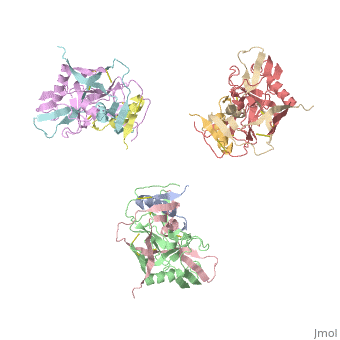Hiv env proteins
From Proteopedia
(Difference between revisions)
| Line 19: | Line 19: | ||
=== Immune Evasion === | === Immune Evasion === | ||
| - | One reason that HIV is able to escape inhibition by the immune system, is because of its conformational variability and resistance to antibodies. Essentially "the conformational flexibility of gp120 facilitates a decoy strategy that misdirects the humoral immune response" <ref name= | + | One reason that HIV is able to escape inhibition by the immune system, is because of its conformational variability and resistance to antibodies. Essentially "the conformational flexibility of gp120 facilitates a decoy strategy that misdirects the humoral immune response" <ref name=Lisa>PMID: 19965434 </ref>. The interaction between CD4-binding site (CD4BS) antibodies and gp120 has been studied using many different antibodies. It has been observed that CD4BS antibodies displace the "four stranded 'bridging sheet'... to uncover a hydrophobic surface... that most CD4BS antibodies rely on access to" <ref name=Lisa>PMID: 19965434 </ref>. In the trimer this causes clashing between the gp120 monomers, which represent constraining factors that prevent the binding and inhibition by antibodies to gp120. The displacement of the bridging sheets, cause conformational changes in the V1/V2 causing clashes in the trimer. "Thus, CD4BS antibodies that access the hydrophobic region under the bridging sheet induce conformation in gp120 that are poorly compatible with the functional viral spike" <ref name=Lisa>PMID: 19965434 </ref>. "The bridging sheet and the V1/V2 loops detect and amplify any recognition that strays outside the target site" <ref name=Lisa>PMID: 19965434 </ref>. |
| Line 37: | Line 37: | ||
There is currently no cure or vaccine for HIV. Thus, there are constantly new studies being conducted, that explore various aspects of HIV. One recent study done at the University of Amsterdam, explored the evolution of HIV post-infection and discovered that HIV can evolve glycan structures that induce the production of broadly cross neutralizing (BCN) antibodies. "The role of glycans in shielding neutralizing epitopes has | There is currently no cure or vaccine for HIV. Thus, there are constantly new studies being conducted, that explore various aspects of HIV. One recent study done at the University of Amsterdam, explored the evolution of HIV post-infection and discovered that HIV can evolve glycan structures that induce the production of broadly cross neutralizing (BCN) antibodies. "The role of glycans in shielding neutralizing epitopes has | ||
long been known but it has only recently become clear that many BCN responses directly target glycans, including the one that evolves at | long been known but it has only recently become clear that many BCN responses directly target glycans, including the one that evolves at | ||
| - | <scene name='Hiv_env_proteins/Asn_glycosylation/1'>position 332</scene> on the gp120 construct"<ref name= | + | <scene name='Hiv_env_proteins/Asn_glycosylation/1'>position 332</scene> on the gp120 construct"<ref name=Luis>PMID: 23086475 </ref>. |
Revision as of 23:57, 27 November 2012
| |||||||||||
| |||||||||||
| |||||||||||
References
- ↑ 1.0 1.1 1.2 1.3 1.4 1.5 1.6 1.7 1.8 Frey G, Chen J, Rits-Volloch S, Freeman MM, Zolla-Pazner S, Chen B. Distinct conformational states of HIV-1 gp41 are recognized by neutralizing and non-neutralizing antibodies. Nat Struct Mol Biol. 2010 Dec;17(12):1486-91. Epub 2010 Nov 14. PMID:21076402 doi:10.1038/nsmb.1950
- ↑ 2.0 2.1 2.2 2.3 2.4 2.5 2.6 Liu J, Bartesaghi A, Borgnia MJ, Sapiro G, Subramaniam S. Molecular architecture of native HIV-1 gp120 trimers. Nature. 2008 Sep 4;455(7209):109-13. Epub 2008 Jul 30. PMID:18668044 doi:10.1038/nature07159
- ↑ 3.0 3.1 3.2 Kwong PD, Wyatt R, Robinson J, Sweet RW, Sodroski J, Hendrickson WA. Structure of an HIV gp120 envelope glycoprotein in complex with the CD4 receptor and a neutralizing human antibody. Nature. 1998 Jun 18;393(6686):648-59. PMID:9641677 doi:10.1038/31405
- ↑ 4.0 4.1 4.2 4.3 Chen L, Do Kwon Y, Zhou T, Wu X, O'Dell S, Cavacini L, Hessell AJ, Pancera M, Tang M, Xu L, Yang ZY, Zhang MY, Arthos J, Burton DR, Dimitrov DS, Nabel GJ, Posner MR, Sodroski J, Wyatt R, Mascola JR, Kwong PD. Structural basis of immune evasion at the site of CD4 attachment on HIV-1 gp120. Science. 2009 Nov 20;326(5956):1123-7. PMID:19965434 doi:326/5956/1123
- ↑ Moore PL, Gray ES, Wibmer CK, Bhiman JN, Nonyane M, Sheward DJ, Hermanus T, Bajimaya S, Tumba NL, Abrahams MR, Lambson BE, Ranchobe N, Ping L, Ngandu N, Karim QA, Karim SS, Swanstrom RI, Seaman MS, Williamson C, Morris L. Evolution of an HIV glycan-dependent broadly neutralizing antibody epitope through immune escape. Nat Med. 2012 Nov;18(11):1688-92. doi: 10.1038/nm.2985. Epub 2012 Oct 21. PMID:23086475 doi:10.1038/nm.2985




